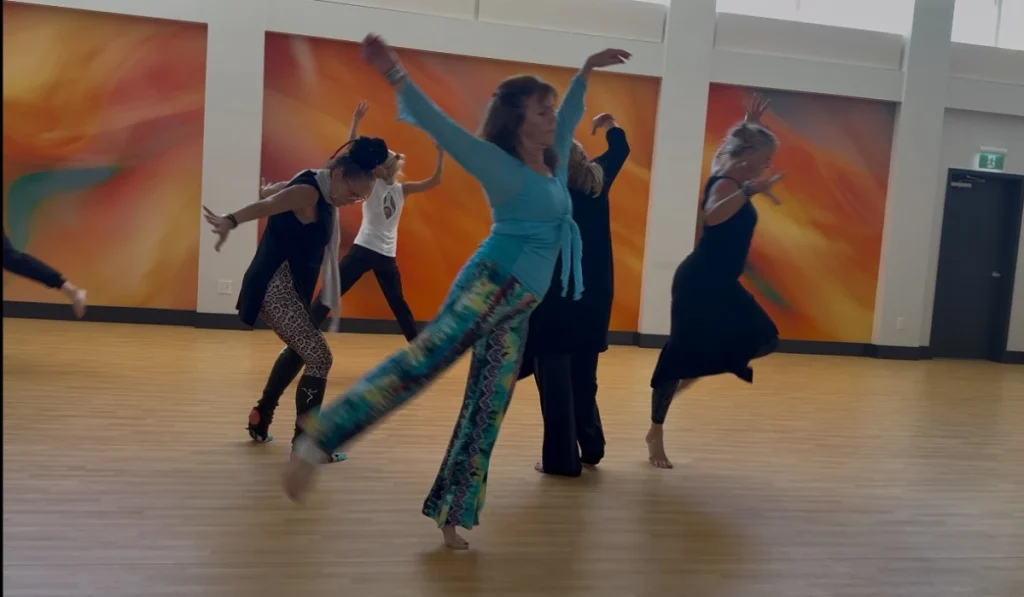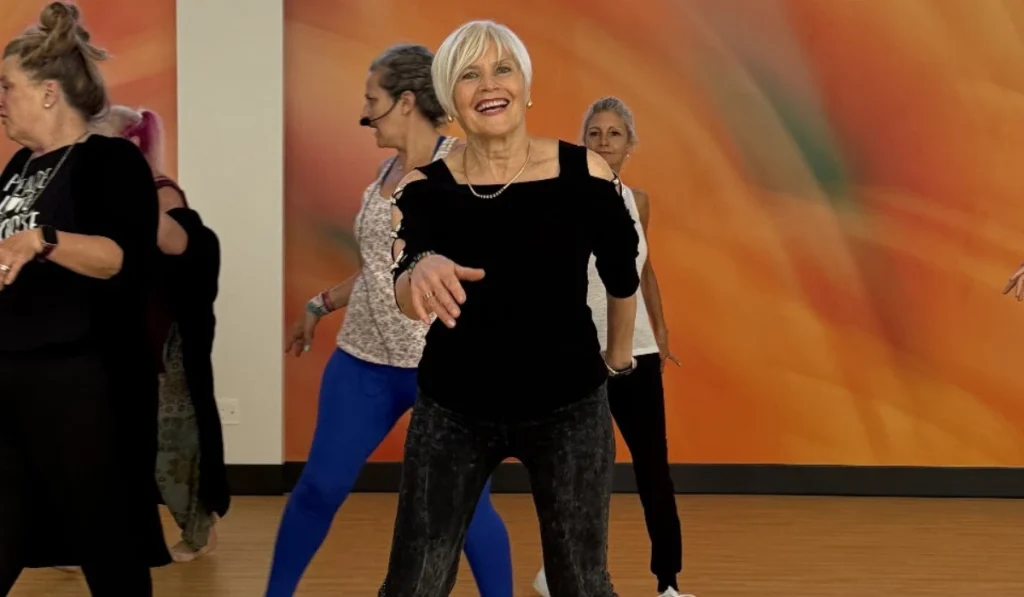Dancing does more than just entertain – it brings remarkable health benefits. A study in the American Journal of Dance Therapy shows that dancing can reduce cortisol levels by a lot. This hormone makes us feel stressed. Moving to music not only creates fun but actively helps our wellbeing.
The benefits reach far into our mental health too. Group dance classes help reduce depression, anxiety and stress symptoms, as research from the National Institute of Health reveals. These classes also build self-esteem and help people connect better socially. Our bodies use movement to process emotions and find inner balance naturally.
This piece explores how dance improves our physical health through better heart function and blood flow. It helps express our emotions and sharpens our thinking while building social bonds. You might never have stepped onto a dance floor, or you might be an experienced dancer. Either way, knowing these benefits could spark your interest to move to the rhythm and improve your health.
How dance helps release emotional stress

Have you noticed how certain movements can instantly change your mood? The emotional healing power of dance comes from its natural connection between mind and body through purposeful movement.
Why movement is a powerful emotional outlet
Our bodies store emotions physically. You might notice stress in your tight shoulders, anxiety makes your heart race, and trauma leaves lasting physical marks. Almost any type of exercise can relieve stress by boosting endorphins – those feel-good brain chemicals. Movement therapy helps you express yourself and release emotions, which lets you process and heal from emotional trauma.
The word “emotion” comes from the Latin “emovere” which means to move out or move through. This shows why movement works so well – emotions need to flow through us naturally. Rhythmic activities create a powerful mind-body connection that reduces anxiety and stops negative thoughts.
Dancing as a non-verbal form of expression
Words often fall short when we try to describe complex emotions. Dance gives us a wordless language to express what stays trapped inside. Research shows that 98% of conscious dance participants felt better after dancing, and many said it helped clear their troubled thoughts.
Dance goes beyond words. Your body can express stress, anger, or sadness that you might struggle to put into words. This helps people who find it hard to talk about their feelings by giving them a physical way to communicate.
Letting go through rhythm and flow
Experts call dance “meditation in motion.” The rhythmic movements help you forget daily stress as you focus on your body and breathing. When you listen to music with engaging rhythmic patterns, it triggers your brain’s reward system and creates a state of “flow” that builds emotional strength.
Dr. Bruce Perry explains that repeated, rhythmic physical activity makes us feel safe and helps regulate our emotions. Dancing also reduces stress through emotional expression and social connection.
This mix of music, movement, and expression creates a powerful emotional healing tool that works better than many traditional stress management methods.
The physical health benefits of dancing

Dancing works wonders on your cardiovascular system, muscles and joints. Your body changes in amazing ways when you make dancing part of your daily routine.
Improved heart health and circulation
Dancing provides powerful benefits for your heart. Research shows dancers who practice at moderate intensity have a 46% lower risk of heart disease or death over 10 years. This protection is substantially better than walking, which only reduces risk by 25%. The combination of brief high-intensity movements with sustained moderate activity makes dancing so effective.
Your heart rate stays elevated throughout each dance session. This strengthens your cardiovascular system and improves blood flow. Regular dancing lowers blood pressure, boosts stamina, and reduces heart disease risks.
Better flexibility and joint mobility
Your body becomes naturally more flexible as you stretch and move in different directions while dancing. The movements boost joint mobility and reduce stiffness. Dancing stimulates production of synovial fluid – your body’s natural joint lubricant.
Dancing provides gentle yet effective movement for people with joint issues. The rhythmic movements improve joint function. Better flexibility makes daily activities easier and lifts quality of life.
Boosting endurance and muscle tone
Dancing gives you a complete body workout that involves multiple muscle groups. Different styles target specific areas – hip-hop builds core strength and explosive power, while ballet develops controlled strength and precise muscle control.
The activity strengthens muscles around your joints, which provides better support and lowers injury risk. This targeted development creates balanced strength throughout your body. Your posture improves and back pain decreases.
Weight management through regular movement
Dancing helps you manage weight effectively. A 30-minute session can burn between 90-252 calories, depending on style and body weight. Studies show dancing works just as well for weight loss as jogging or cycling.
People who dance regularly see real improvements in body mass, BMI, waist size, and body fat percentage compared to non-exercisers. The fun nature of dancing makes it easier to stick with – a vital factor to manage weight long-term.
Mental clarity and mood improvement through dance
The mind-body connection in dance goes deeper than most people realize. Your brain undergoes powerful chemical changes that affect your mental well-being when you move to rhythm.
How dance reduces cortisol and boosts endorphins
Research shows that dance and movement training lowers salivary cortisol levels. This drop in your body’s main stress hormone creates positive mental changes. Dancing releases endorphins—the same chemicals that create a “runner’s high”. These natural compounds kill pain and lift your mood.
Dance creates a complete “neurochemical symphony” in your brain. Your dopamine levels rise as you anticipate the melody. Physical movement releases endorphins, while dancing with others boosts oxytocin levels. These three hormones work together to lift your mood, build stronger social connections, and naturally reduce stress.
The role of music and rhythm in mental focus
Music lights up several brain regions at once, especially your limbic system (including the hypothalamus, amygdala and hippocampus) and cerebral cortex. Moving to music’s rhythm [link_2] strengthens neural connections, which boosts neuroplasticity and makes your brain work better.
Your brain juggles complex motor planning, memory recall, multitasking, and focused attention while dancing. These mental challenges create new neural pathways that boost your mental clarity and cognitive resilience.
Dance as a mindfulness practice
Dance naturally puts you in a mindful state—a present-centered awareness that helps you cope better and control your emotions. You become more mindful when you focus on your body “from within” during dance. This helps you let go of worrying thoughts and understand yourself better.
Studies show that all but one of these conscious dance participants feel more connected to their emotions, and 98% say their mood improves. Dance offers a unique edge over regular meditation because it helps people who find it hard to sit still get the same mindfulness benefits.
Building confidence and social connection

Dance offers more than just physical and emotional advantages – it opens up new possibilities for social growth and personal discovery. This powerful mix builds inner confidence and strengthens connections with others.
Learning new moves and gaining self-trust
Dancers build genuine confidence as they master new steps. Research shows that 93% of participants agree dance improves their self-confidence. The original steps might seem daunting, but each mastered move builds confidence and creates an upward spiral of achievement.
Dance programs show clear benefits for personal growth, awareness, and trust. Dancers develop a deeper connection with their bodies through physical mastery. This newfound capability extends to other aspects of life and helps them face challenges with confidence.
Group dancing and community bonding
Communities run on dance, which creates lasting bonds between people. Studies show that moving in sync with others helps people tolerate pain better and feel more connected. This synchronization creates a shared experience where dancers become part of something bigger.
People build friendships in dance studios that last beyond their classes. 70% of participants in one study made new social connections during dance sessions and stayed in touch afterward. These bonds create a welcoming space where everyone feels valued and accepted.
Overcoming isolation through shared movement
Dance serves as a powerful antidote to social isolation. Research describes it as “the solution for hundreds of thousands of people around the world, lifting spirits and connecting us with every single step”. Dance became a crucial way to connect during the COVID-19 pandemic, even through virtual platforms.
Adults who completed a 12-week dance program reported four main themes, including “connection with others” and “not wanting to stop” because of unexpected benefits. Members developed a sense of belonging and group identity that helped reduce depression and isolation.
Conclusion
Dance is one of the most available and powerful healing practices we have today. Movement can turn stress into release, sadness into expression, and isolation into connection. The numbers tell a compelling story – dancing cuts heart disease risk by 46% and 98% of people report better moods after they dance.
Dancing does more than just relieve stress – it’s a complete health package. Each beat of the music makes your heart stronger. Every sway increases your joints’ mobility. The choreographed sequences help develop balanced muscle tone. You can manage weight naturally through this enjoyable activity instead of following a punishing exercise routine.
Dancing creates what many call “meditation in motion,” and it makes a big difference. This state helps us escape our mind’s constant chatter while making our thinking clearer. The rhythmic movements create the perfect mix of brain chemicals – endorphins, dopamine, and oxytocin. These work together to boost our mood and sharpen our focus.
The shared experience of moving together encourages trust and belonging. People who dance find new confidence that spreads way beyond the reach and influence of the dance floor. Those feeling alone find their community, and others find their voice through movement.
Dancing is a fundamental human experience that connects us to our bodies, emotions, and each other. The healing potential is there, whether you dance regularly or haven’t tried it yet. Your first step might feel awkward, but every dancer started somewhere. The second step comes easier, and soon the rhythm will guide you toward better health, clearer thinking, and deeper connections.


